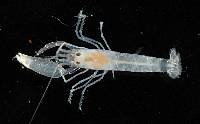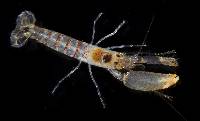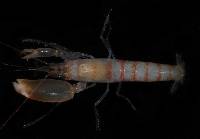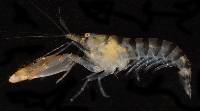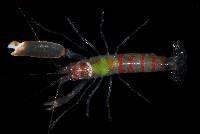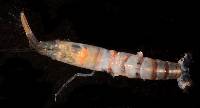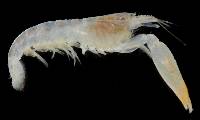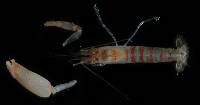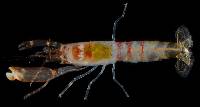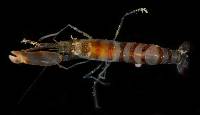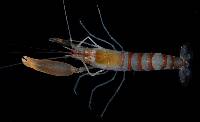
Invert E Base
Reaching back to see the future
|
|
|
|
Family: Alpheidae
smoothclaw snapping shrimp
[Alpheus togatus (Armstrong, 1940)] |
Bocas Species Database Habitat: The species can be commonly found in rocky-bottoms and in sandy areas between (among) corals and Thalassia's meadows. Also it lives between (among) pipes of poloquets. Distribution: Alpheus paracrinitus has a fairly wide range and was reported from Tropical eastern, central and western Atlantic. It is common in the Caribbean region, from Bermuda to Panama and Brazil. Natural History Notes: The taxonomic situation of Alpheus paracrinitus is fairly complex because of the existence of at least 5 cryptic species only in the Atlantic Ocean. In addition to these species, we know that two nominal species, also present in the Atlantic Ocean, have been identified as synonym of A. paracrinitus, as well as 5 other species in the Indo-Pacific region. However, it seems that some of the data used to determine this synonimity were erroneous. Panama is a prime location to conduct various studies on geographic isolations and speciation, because of its incredible geographical situation, with the Caribbean Sea and the eastern Pacific separated by the Isthmus of Panama. In 1993, an interesting study, conducted by Knowlton et al., looked at the biochemical and reproductive divergence of 7 pairs of closely related species of shrimps from the genus Alpheus that are separated by the Isthmus of Panama. A pair would be composed of transisthmian sister species. The authors looked at the divergence in allozymes, mitochondrial DNA and reproductive compatibility. The results showed that the 4 pairs of sister species that were the least divergent could be used to estimate rates of speciation and divergence. In the case of the 3 remaining pairs, the authors suggest that divergence would have occurred even before the land barrier of Panama was completed. Alpheus paracrinitus is closely related to the eastern Pacific species and is one of the 4 pairs least divergent. Depth: Present in the intertidal to about 10 m. Characteristics: Alpheus paracrinitus has a small body length of about 18 mm. Notes: A study conducted by Williams et al. (2001) looked at the phylogenetic relationships within the genus Alpheus, using the sequence data of two nuclear genes and a mitochondrial gene called cytochtome oxidase I. The phylogenetic analyses led to the discovery of three new lineages within the genus Alpheus. Those results suggested that specialized ecological conditions and different claw morphologies among the genus Alpheus would have evolved independently several times. It also raised questions about whether or not the genus Alpheus should be split into three or several genera. The authors suggested that those three lineages should at least receive the status of subgenus. Alpheus rostratus. Alpheus paracrinitus can be distinguished from A. rostratus and its three cryptic species mainly by differences on the body and major chela (claw). |
|
|
|
Powered by Symbiota.












